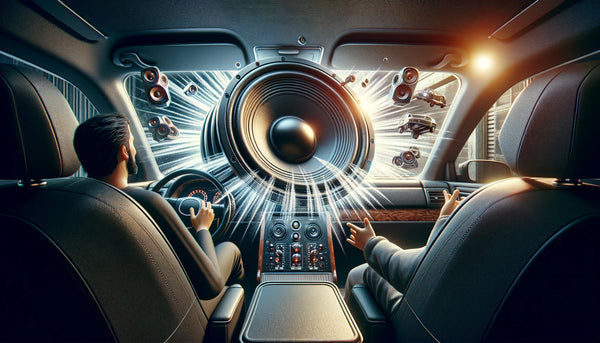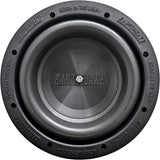Key Highlights
- Passive radiators, particularly car speakers and subwoofers, are essential in speaker systems as they work alongside the main driver to enhance bass performance.
- Passive radiators create sound using air pressure inside the speaker enclosure instead of a powered motor like a traditional subwoofer.
- Tuning the passive radiator's weight, compliance, and resonance frequency allows manufacturers to optimize the system's response and achieve a deeper and more accurate bass reproduction.
- Passive radiators eliminate the need for bulky ports, resulting in a more compact speaker enclosure without sacrificing bass response.
- Size, weight, resonant frequency, and compatibility with the amplifier are factors to consider when selecting a passive radiator.
Introduction
Passive radiators have become a crucial component in speaker systems, revolutionizing how we experience bass performance. Whether in car speakers or home theater setups, these innovative devices work alongside the main driver to enhance the low-frequency response and deliver a more immersive audio experience.
Traditionally, subwoofers relied on a powered motor to produce bass frequencies. However, passive radiators take a different approach. Instead of using a motor, they utilize air pressure inside the speaker enclosure to create sound. This unique design allows passive radiators to deliver a deeper, more accurate bass reproduction.
This blog will explore passive radiators' functionality, engineering principles, and advantages over other bass enhancement techniques. We will also provide practical tips on selecting the correct passive radiator for your speaker system and offer insights into real-world applications and success stories.
By the end of this blog, you will have a comprehensive understanding of passive radiators and how they can enhance your audio experience.
The Basics of Bass Speaker Passive Radiators

Understanding the basics of bass speaker passive radiators is essential to grasp their role in enhancing bass performance. Passive radiators are a critical component in speaker systems, working with the main driver to optimize bass response. Unlike traditional subwoofers that rely on a powered motor, passive radiators use the air pressure inside the speaker enclosure to create sound.
The key factors that determine the performance of passive radiators are their resonant frequency, weight, and compliance. By tuning these parameters, manufacturers can optimize the system's response and achieve a deeper and more accurate bass reproduction. Additionally, passive radiators eliminate the need for bulky ports, allowing for a more compact speaker enclosure without compromising bass response.
Defining Passive Radiators and Their Purpose
Passive radiators, often called passive radiator speakers, are vital in speaker systems designed to enhance bass performance. Unlike active drivers, such as woofers, passive radiators do not have a voice coil or magnet. Instead, they resonate with the air inside the speaker enclosure, allowing for greater low-frequency output.
The primary purpose of passive radiators is to enhance the bass response in a speaker system. By using the resonance of the passive radiator, the low frequencies produced by the active driver can be amplified and reproduced with greater accuracy. The tuning of the passive radiator, including its resonant frequency and weight, is crucial in achieving optimal bass performance.
Passive Radiators in Speaker Design
Passive radiators have come a long way in the evolution of speaker design. With advancements in technology and materials, audio equipment manufacturers have been able to optimize bass performance using passive radiators.
In the past, bulky speaker enclosures and large drivers were necessary to achieve a deep bass response. However, introducing passive radiators has allowed for more compact and aesthetically pleasing speaker designs without sacrificing bass performance. By utilizing the air pressure inside the enclosure, passive radiators enhance the low-frequency response and provide a more immersive audio experience.
Incorporating passive radiators in speaker systems has revolutionized how we enjoy music, movies, and other audio content. These innovative devices have become a staple in car audio speaker systems, home theater setups, and portable Bluetooth speakers, offering a powerful and immersive sound experience.
The Engineering Behind Passive Radiators

Passive radiators enhance bass response by utilizing air pressure within the enclosure. The tuning frequency determines the radiator's resonance for optimal bass performance. Materials like durable suspensions and high-excursion diaphragms impact the overall sound quality. Design choices shape the bass output, including enclosure volume and internal air pressure. By understanding the engineering principles behind passive radiators, you can fine-tune your speaker system for richer sounds.
How Passive Radiators Enhance Bass Response
Passive radiators enhance bass response by utilizing the principles of resonance to amplify low frequencies without additional power. By synchronizing the movement of the passive radiator with the main driver, these radiators boost bass performance, offering a richer sound experience. This synchronized action increases the air pressure within the speaker enclosure, leading to improved bass output and a more detailed audio experience. The result is a deep, powerful bass that effortlessly complements any audio system.
Materials and Design Choices for Optimal Performance
Choosing suitable materials and design elements is crucial for optimal performance when crafting a bass speaker passive radiator. Selecting materials with high durability and the appropriate springiness can enhance bass response. Design choices like the size of the radiator and its resonance frequency significantly impact the overall sound quality. By meticulously considering these aspects, you can ensure that your passive radiator speaker system delivers rich and powerful bass performance that complements your audio setup seamlessly.
Comparing Passive Radiators with Other Bass Enhancement Techniques
Compared to other bass enhancement techniques, passive radiators offer a unique balance of bass response without the added port noise seen in ported enclosures. The synergy between active drivers and passive radiators allows for richer sounds and detailed bass performance, ideal for home theater and car audio setups. Unlike traditional methods that may require more power, passive radiators efficiently utilize internal air pressure for enhanced low frequencies. This comparison highlights the versatility and effectiveness of passive radiators in augmenting bass without compromising sound quality.
Passive Radiators vs. Ported Enclosures

Ported enclosures use a tuned port to enhance bass performance by emphasizing specific frequencies, while passive radiators improve bass response through the motion of a weighted diaphragm. Unlike ports, passive radiators eliminate port noise, offering cleaner sound reproduction. They require less power than ported designs but provide similar bass extensions. Passive radiators are ideal for achieving deep and impactful bass in compact speaker systems where a port may not be practical, offering flexibility in design and enhancing overall audio quality.
The Synergy Between Active Drivers and Passive Radiators
Active drivers and passive radiators work in harmony to deliver robust bass performance. While active drivers directly produce sound, passive radiators enhance low frequencies through resonance—the synergy between the two components results in richer sounds and improved bass response without requiring additional power. A balanced and dynamic sound system is achieved by coordinating the movement of the main driver with the passive radiator's response to internal air pressure changes.
Selecting the Right Passive Radiator for Your Speaker System

When choosing a passive radiator for your speaker system, consider size and tuning frequency for optimal bass performance. Ensure compatibility with speaker enclosures and drivers to maintain synergy. The correct passive radiator can elevate your sound system by enhancing bass response efficiently. Make informed decisions based on the materials and design choices to achieve richer sound quality. Selecting the appropriate passive radiator tailored to your needs is crucial for maximizing bass performance and overall audio experience.
Size and Tuning Frequency Considerations

Size and tuning frequency are crucial when considering passive radiators for bass speaker systems. The passive radiator's size must equal or exceed the main driver's size with equal or more excursion to ensure optimal bass performance. Pro Tip: Use two passive radiators per active subwoofer for exceptional results. You will have to increase the weight added to each passive significantly, but the results are well worth it.
Tuning frequency dictates the passive radiator's resonant frequency, impacting the overall sound quality. Matching the size and tuning frequency correctly can result in a harmonious bass response that enhances the audio experience significantly. Proper consideration of these factors is essential for achieving the desired bass performance.
Compatibility with Speaker Enclosures and Drivers
Assessing the physical and technical aspects is crucial when considering the compatibility of passive radiators with speaker enclosures and drivers. Achieving optimal bass performance requires carefully matching the passive radiator's parameters with the main driver and enclosure volume. Ensuring resonance frequencies align and that the passive radiator can handle the power from the main driver is essential. The overall design should also support efficient air movement within the enclosure to maximize bass response and sound quality.
Installation Tips for Maximum Bass Impact

Correctly positioning and mounting your passive radiator is essential for achieving optimal sound quality. To maximize bass impact, place the speaker in a well-ventilated area for proper air pressure distribution. Fine-tune the passive radiator to achieve the desired bass response by adjusting its placement within the speaker enclosure. Ensuring the passive radiator is securely mounted will prevent vibrations and rattling issues that could compromise the overall sound system performance. Fine-tuning is vital for a truly immersive audio experience.
Positioning and Mounting for Optimal Sound Quality
Positioning and mounting play crucial roles when optimizing sound quality with passive radiators. Placing passive radiators symmetrically about the main drivers can enhance bass performance. Mounting them securely within the speaker enclosure prevents unwanted vibrations. Proper positioning ensures efficient air pressure management and a clearer bass response. You can achieve a well-balanced sound system with rich bass tones by strategically placing passive radiators. Implementing these techniques elevates the overall audio experience, delivering detailed sound reproduction.
Fine-Tuning Passive Radiators for Desired Bass Response
To optimize your passive radiators for the perfect bass response, experiment with different weights on the passive radiator to adjust resonance. Fine-tune the system by altering the compliance and mass of the passive radiator for desired bass levels. Ensuring the passive radiator's parameters match the main driver's characteristics is critical. Monitor the response carefully and make incremental adjustments for optimal performance. This detailed fine-tuning process can significantly enhance your audio experience. Make the most of your passive radiators for a richer bass output.
Real-World Applications and Success Stories
Case studies showcase how passive radiators enrich sound systems. Users report enhanced bass performance in home theaters and car audio setups. These real-world applications underline the efficacy of passive radiators in subwoofer cabinets and speaker enclosures. Positive user feedback emphasizes the impact on bass response and overall sound quality. From Bluetooth speakers to high-performance systems, passive radiators deliver richer sounds with less power. Success stories affirm the value of passive radiator speaker integration for immersive audio experiences.
Case Studies of High-Performance Systems with Passive Radiators
Case studies reveal the prowess of high-performance systems incorporating passive radiators. In car audio setups, these systems demonstrate superior bass performance through optimized air pressure control. Home theater applications showcase how passive radiators enhance low frequencies without requiring extra power. Such real-world examples highlight the impact of passive radiators in delivering richer sounds with detailed bass responses. The success stories underscore how these systems elevate the overall sound quality, making them a preferred choice for audiophiles.
User Experiences and Feedback on Passive Radiator Setups
User experiences and feedback on passive radiator setups are crucial in understanding the real-world implications of integrating this technology into sound systems. Enthusiasts often highlight the enhanced bass performance and overall sound quality achieved through passive radiators. Their feedback provides invaluable insights into the practical benefits and challenges faced when utilizing passive radiators in different audio setups, whether in car audio systems, home theaters, or portable Bluetooth speakers. Gathering diverse user experiences helps potential adopters make informed decisions based on detailed information and first-hand accounts.
Overcoming Common Challenges with Passive Radiators

Addressing vibrations and rattling issues in passive radiators is crucial for maintaining optimal sound quality. Ensuring the durability of passive radiators involves proper installation techniques and materials that can withstand high excursion levels. Passive radiators can deliver consistent bass performance without distortion by mitigating resonance issues and controlling internal air pressure within speaker enclosures. Implementing these strategies will help overcome common challenges associated with passive radiators in audio systems.
Ensuring Longevity and Durability of Passive Radiators
Proper care is essential to ensure the longevity and durability of passive radiators. Avoid subjecting them to excessive power levels, which can lead to damage. Keeping passive radiators clean from dust and debris also contributes to their longevity. Additionally, ensuring the integrity of the enclosure and components around the passive radiators can prevent unexpected failures. Regular maintenance and periodic checks on the passive radiators' condition can help prolong their lifespan and maintain optimal performance.
Conclusion
Passive radiators play a crucial role in enhancing bass response, offering optimal performance in speaker design. With careful selection based on size, tuning frequency, and enclosure compatibility, passive radiators can significantly elevate your audio experience. By understanding its engineering and benefits, you can fine-tune your system for maximum bass impact. Real-world success stories and user feedback highlight the effectiveness of passive radiators in delivering high-quality sound. Overcoming challenges like vibrations and ensuring durability are vital aspects to consider. By delving into the world of passive radiators, you can unlock the potential for superior bass performance in your speaker setup.
Frequently Asked Questions

Can I replace a damaged passive radiator myself?
You can replace a damaged passive radiator with essential tools and skills. Ensure compatibility with your speaker system, follow installation instructions carefully, and consider seeking professional advice if needed for optimal performance.
How do I know if a passive radiator is correct for my speaker system?
Passive radiators enhance bass without power. To choose, consider your speaker's size and desired bass response. Ensure compatibility with your system's drivers and enclosures for optimal performance. Evaluate if increased bass depth and quality align with your audio preferences.








